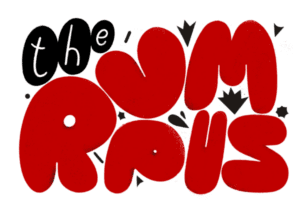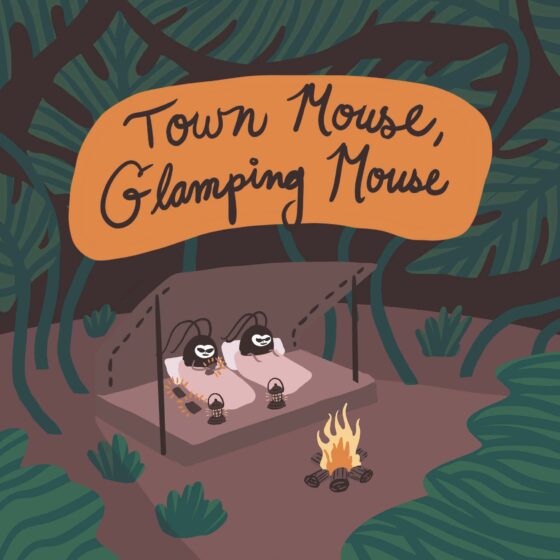The New York Comics & Picture-Story Symposium is a weekly forum for discussing the tradition and future of text/image work. Open to the public, it meets Tuesday nights 7-9 p.m. EST in New York City. Presentations vary weekly and include everything from historical topics and technical demonstrations to creators presenting their work. Check out upcoming meetings here.
The 105th meeting of the NY Comics & Picture-Story Symposium was held on Tuesday, October 28, 2014. Art and comics historian Eddy Portnoy presented a history of Yiddish cartoons.
Jews and cartoons have an unusual relationship. Initially, Jews were the victims of a particularly virulent anti-Jewish caricature, and did not engage the form within the context of their own culture until the second half of the nineteenth century in the Yiddish press. Though little-known, the cartoons of the Yiddish press serve as a pre-history to subsequent activity in the field by Jewish artists.
I. Europe
European Jews didn’t have access to art schools in the 18th and 19th centuries, where Eddy Portnoy begins his history. Documents of value from the medieval period exist, but rarely pictures. Some explain this as a pious shying away from graven images. But, as in every culture, Jews wrote and drew, primarily about themselves, and it was only a matter of time before they adopted the technology to reproduce pictures.
Jews wrote and drew, primarily about themselves, and it was only a matter of time before they adopted the technology to reproduce pictures.
Unfortunately, Jews have had their share of negative representation almost from the beginning. A 1479 cartoon of Simon of Trent portrays the infamous blood-libel myth that Jews consume the blood of children. There’s a perennial portrayal of Jews suckling pigs—judenachwine—in European culture. And a common pictorial convention was to depict Jews wearing yellow badges and hats.
Over the centuries in Germany, the swine and the Jewish wet-nurse commonly appear in pictures and as gargoyles, most famously in a representation of Jews plundering a street in Frankfurt in 1413 (Simon of Trent makes a cameo appearance). By the 18th century, though, German Jews began to assimilate and acculturate. They came to speak German instead of Yiddish, dressed like Germans, and even changed their religion to Christianity.
But no matter how German Jews of this period may have dressed, spoken, or assimilated, a certain strain could not accept Jews as being German. In a time before DNA testing, a pseudoscientist named Wilhelm Marr took it upon himself to distinguish the Jew genetically from the true German. He coined the term “anti-Semitism” in 1879, and soon came a wave of cartoons caricaturing Jews on election posters, magazines like La Libra Parole, everywhere. Marr found an immediately recognizable, inherited trait to identify Jews in a time and place wherein Jews no longer wore yellow badges or hats: the big nose.
In 19th-century France, nothing stirred both Jewish and anti-Jewish feeling like the Dreyfus affair, in which the first Jew to ascend to his rank in the French army was accused of spying for the German military. Dreyfus was eventually exonerated, but not before a wealth of anti-Semitic cartoons were published, mostly in broadsheets like Musee des Horreurs.
The Russian empire had a clamp on publishing all through its history. By the middle of the nineteenth century Russia had acquired a huge section of Poland, which held the largest Jewish population in he world, but it prohibited Jews from publishing until a more tolerant czar, Alexander, came to power and allowed Jews to publish a Hebrew newspaper. Of course, Hebrew was a dead language at that time with maybe 100,000 speakers, when everyone else in Russia’s territory spoke Yiddish—so much for tolerance. Alexander Tsederboym published a Yiddish paper that ran from a few years, until the Russian government closed it down. (Tsederboym tried another Yiddish paper a few years later.) One generation later, after the 1905 failed revolution, things got a bit freer, and there’s a wealth of published humor from 1905-1917, but after he revolution of 1917, things got repressive again.
II. America
From 1881 to 1920, millions of Jews emigrated to the United States. One particular cartoon, appearing in an 1881 in issue of the American humor magazine Puck characterizes the plight of immigrating Jews as sailing on a ship on rough seas. Unlike most cartoons about Jews, this was a positive statement and sympathetic to the plight of these people ready to be new Americans. But the familiar iconography is there: along with Uncle Sam, 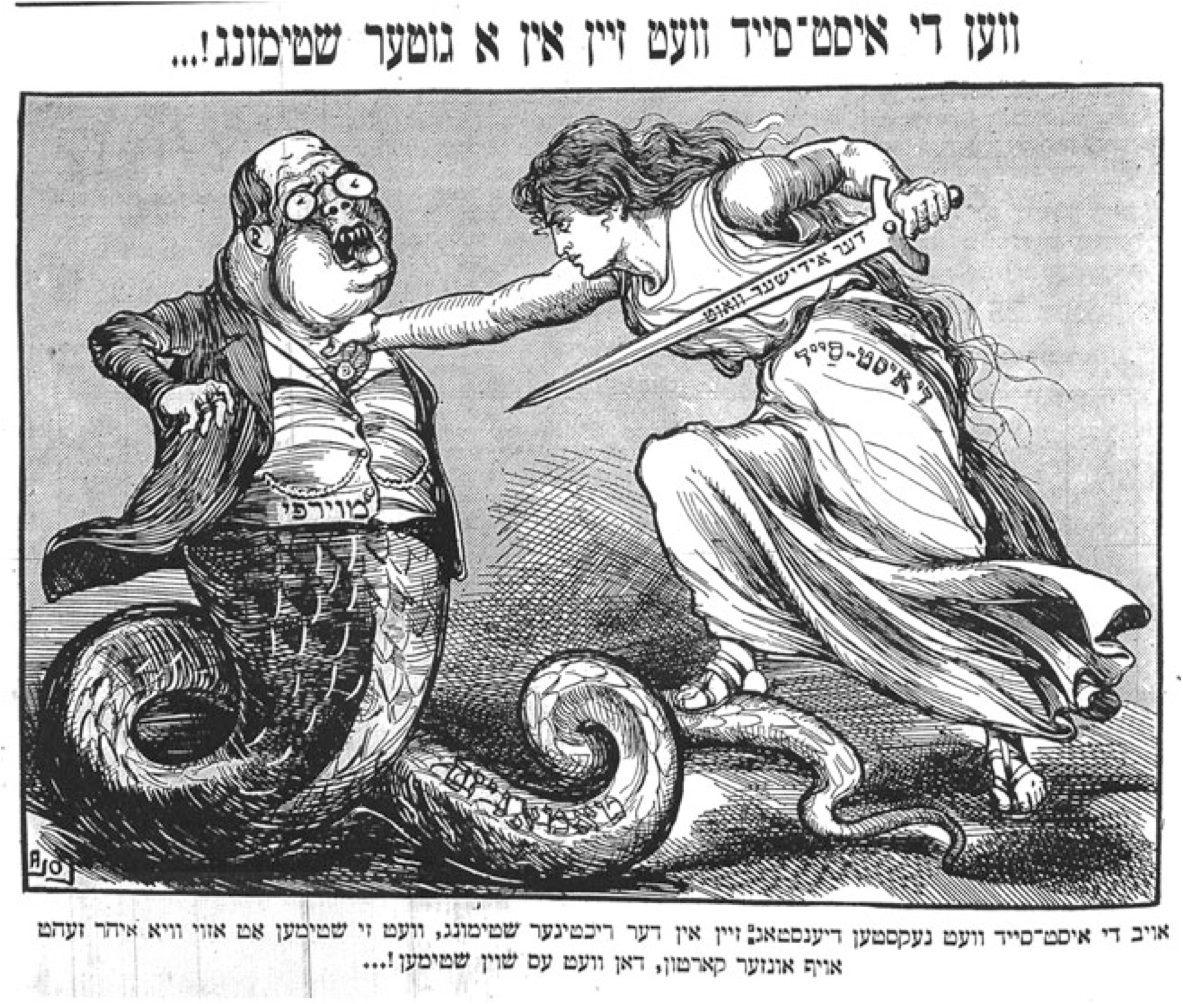 there are stereotypical Jews with their big noses, and a Jewish caricature appears on the side of the boat.
there are stereotypical Jews with their big noses, and a Jewish caricature appears on the side of the boat.
Ethnic caricature and stereotype took a firm hold in early 20th century American culture, in postcards, broadsheets, and, most prominently, on the cover illustrations for sheet music. Cartoons for songs like “Wop, Wop, Wop!” stereotyping Italians, and “Coon Coon Coon,” stereotyping African-Americans, were tremendously popular. Widespread reading fare also included books of Irish jokes, “Hebrew” Jokes, Yiddish jokes, and so on. They were literally a dime a dozen.
The response by the Jewish community was not hostility, but rather, “We can do that better,” and Jews began to make cartoons of themselves, and of Jewish life in general. “Yonkel the Cow-Boy Jew,” and “Mosha from Nova Scotia” were big sellers. Irving Berlin wrote “Cohen Owes Me Ninety Seven Dollars,” and a Jew-faced character became stock-in-trade in vaudeville. To be fair, some Jews took offense. One rabbinical organization at the time claimed that such material was offensive, but it was so full of Yiddishisms and references to Jewish life that only a Jew could understand it.
IV. Newspapers
The first Jewish publications contained no graphics, as there were more writers than could fit in a newspaper. Cartoons gradually crept their way in. The year 1870 saw the premiere of The Hebrew Times, a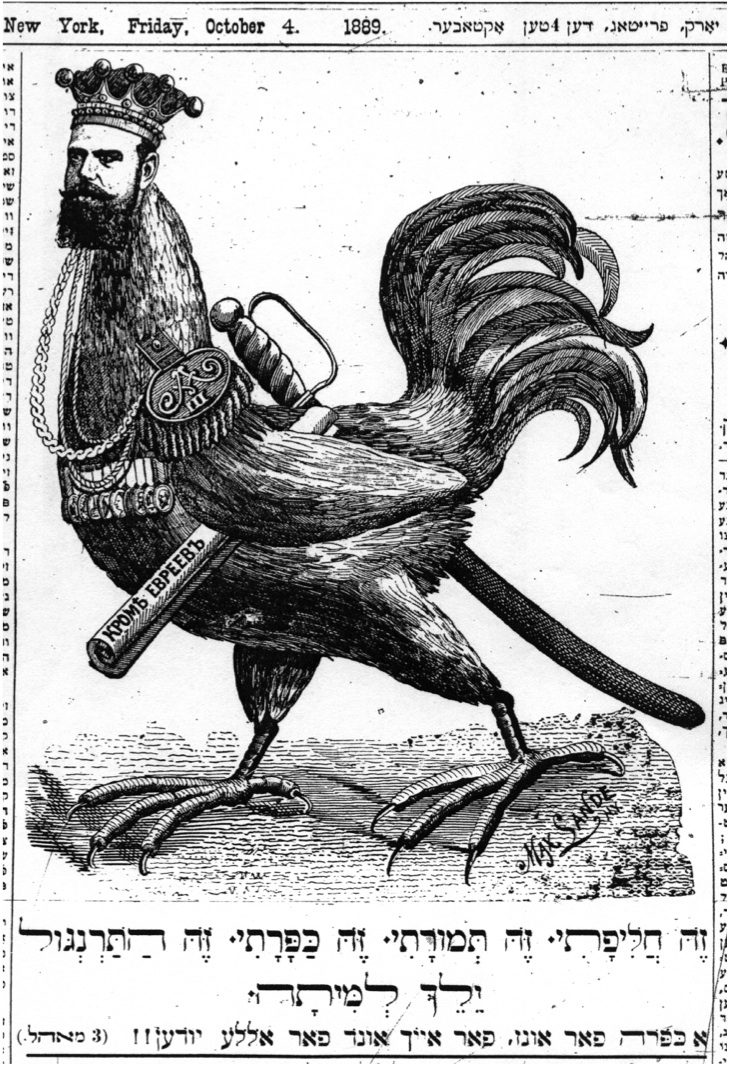 curiously hand-lettered and lithographed newspaper (as opposed to set type), with text written in four languages, including Hebrew, and the editorial line was decidedly pro-Tamany Hall. This paper ran images that had nothing had to do with the text, but were merely space fillers. In 1876, they began to appropriate images from other papers.
curiously hand-lettered and lithographed newspaper (as opposed to set type), with text written in four languages, including Hebrew, and the editorial line was decidedly pro-Tamany Hall. This paper ran images that had nothing had to do with the text, but were merely space fillers. In 1876, they began to appropriate images from other papers.
Although the bulk of Yiddish cartooning over the years was in single-panel format, with extensive captions that often took up more space than the artwork itself, we begin to see multi-panel cartooning emerge, as the Yiddish press imitated the mainstream press, around the turn of the century. There was a daily strip called Di Tsayt about a perennially unemployed character premiered in 1912. Another daily ran about a matchmaker named Gimpl-Beynesh der Shadkhn (“Gimpl-Beynesh the Matchmaker”). The Forward—which first appeared in 1897 and became one of the most influential Yiddish language papers—created a Sunday funnies page in 1915 called “The Step Child” which ran until 1920. Speech balloons appear in addition to the captions.
The Jewish Gazette, which first appeared in 1886, also starts to look like a modern newspaper around this time. There was even a Passover supplement one year, in which was published the Gazette‘s first cartoon. Apparently, the Jewish Gazette liked something in the Puck cartoon called “The Transatlantic Hebrew Line” mentioned above, as they ran it and re-captioned it “Next Year in Jerusalem,” the prayer that ends the Seder dinner and expresses hope for a better life.
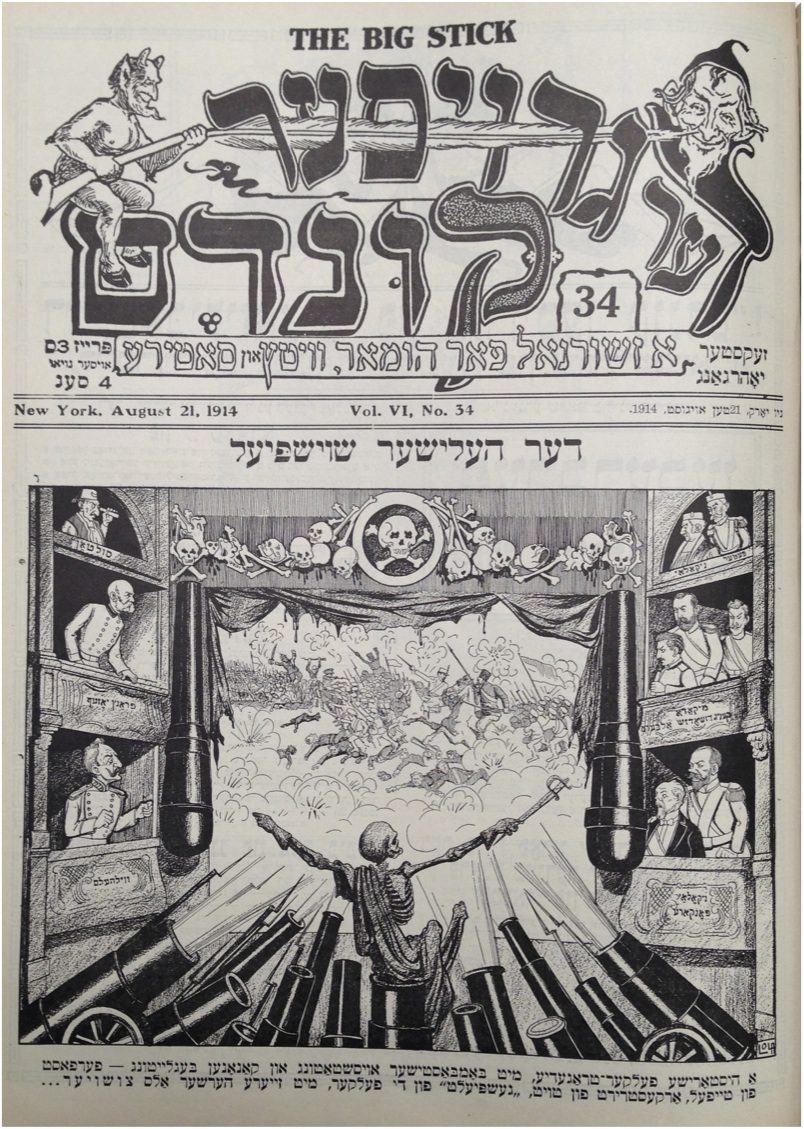 In 1889 came the first Yiddish political cartoon, depicting a chicken with the head of Tsar Alexander, referring to the Jewish custom of kaporus, involving swinging a decapitated chicken over one’s head before Passover. The Hebrew Puck (or Yiddishe Puck) reprinted cartoons from other magazines, but didn’t succeed. The Jewish Morning ran a “This Day in Jewish History” feature, and, in 1908, a group founded a humor magazine called The Kibitzer, and Der Groyser Kundes (“The Great Prankster”) also premiered.
In 1889 came the first Yiddish political cartoon, depicting a chicken with the head of Tsar Alexander, referring to the Jewish custom of kaporus, involving swinging a decapitated chicken over one’s head before Passover. The Hebrew Puck (or Yiddishe Puck) reprinted cartoons from other magazines, but didn’t succeed. The Jewish Morning ran a “This Day in Jewish History” feature, and, in 1908, a group founded a humor magazine called The Kibitzer, and Der Groyser Kundes (“The Great Prankster”) also premiered.
Perhaps the strongest cartoon to appear in a Yiddish publication was “The Hellish Drama” depicting the misery and suffering created by World War I, which ran on the front page of Ded Kundes (“The Big Stick”) This paper, as with most Jewish publications, was decidedly socialist in its leanings, although the horror of this futile war surely cut across ideological or ethnic, lines.
V. The 20th Century
By the 20th century, Yiddish newspapers had become the largest foreign language press in the US. The Forward printed about 250,000 copies per issue, putting their total readership at about 750,000. Twenty percent of New York City was Yiddish speaking. At the end of Word War I, there were five major Yiddish newspapers. And, as newspapers were the only real form of mass media, especially for Yiddish speakers, back then, this became a forum for the cartoonists like Art Young, who also worked for The Masses and other publications. Against the tide of public opinion, Young was a conscientious objector to WWI, and consequently the Yiddish press was the only place he could get work. Abie the Agent was one of the first mainstream cartoon series to be adopted in the Yiddish press. Another one was Milt Gross’s Nize Baby. William Gropper also found a vehicle for his cartoons in the Yiddish press.
Even though, as elsewhere, Yiddish cartoonists saw cartooning as a lower-class art, beneath the level of fine art and painting, all their work remains for us highly expressive, powerful, and worth celebrating.
***
Image credits:
Image 1: “Asmodeus blesses the Hanukkah candles,” Leyb Brodaty, Der Ashmeday, Berlin/Warsaw, December 1913
Image 2: “What will happen in the election if the East Side is in a good mood,” Lola, Der Groyser Kundes, New York, November 12, 1912
Image 3: “Tsar Aleksander III as a Yom Kippur sacrifice,” Max Sande, Nyu-Yorker Yidisher Folkstsaytung, New York, October, 4, 1889
Image 4: “The Hellish Drama,” Lola, Der Groyser Kundes, New York, August 21, 1914
(All images © YIVO Institute for Jewish Research.)
***
Eddy Portnoy teaches in the Judaic Studies program at Rutgers University and also serves as the academic advisor at the YIVO Institute for Jewish Research. In addition to curating exhibits, he writes and lectures on Jewish popular culture.
***
About the author: Mark Lerer holds a bachelor’s degree from Princeton University and an M.F.A. from the New York Academy of Art. His cartoon drawings have been published in the New York Post, have appeared at New Century Artists and Nexus galleries, and are regularly featured on Facebook.
